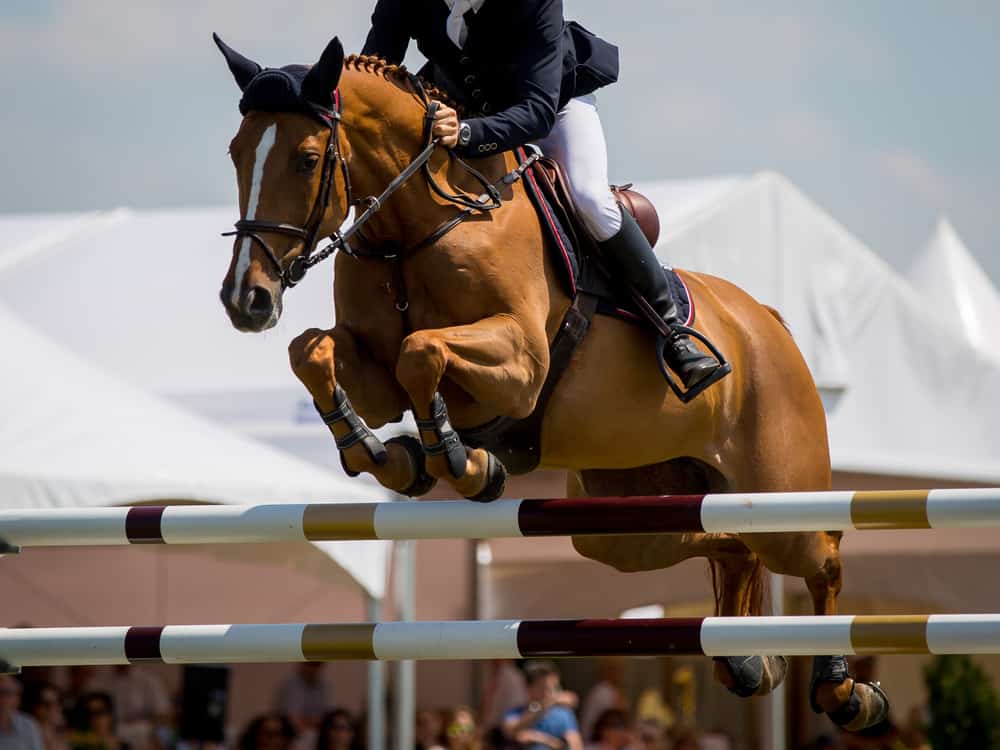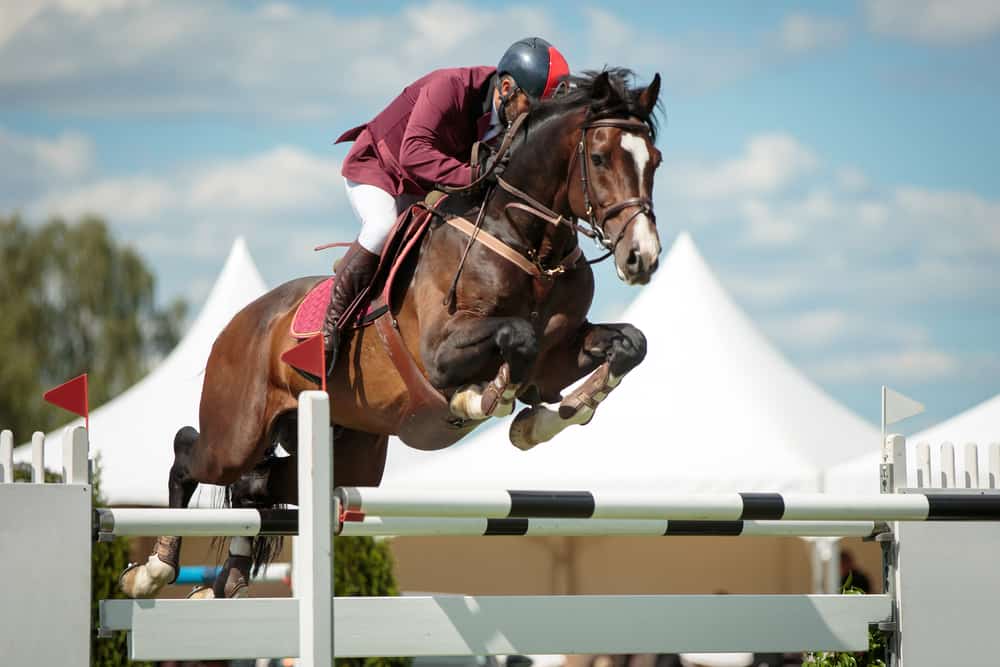Showjumping
Riding a 500 kg animal with a will of its own can be unpredictable at full speed, and steering them to jump over high fences can be very dangerous. There are around 60 000 horse-related injuries every year. So is showjumping dangerous?
Showjumping is one of the most dangerous horse sports and has many risks involved. Every year many horse riders are injured, admitted to hospital, or killed due to riding accidents. Every time you get on a horse, you are taking a risk.
The risk of showjumping is higher than general horse riding and is more dangerous than motorcycling, football, and skiing. In this article, we will explain the dangers of this sport and how to avoid them.
What are the dangers of Showjumping and how to avoid them?
Here are some of the dangers of showjumping that you should be aware of:
Falling
Falls happen mostly when a rider or horse makes an error. The more experienced rider you are, the less likely you are to fall. Investing in a professional trainer to help you gain a secure and confident seat will significantly decrease your chances of making a mistake in the arena. However, there is a saying; you are not a rider until you have fallen off seven times.
Foot stuck in the stirrup
This is one of the more dangerous accidents that can happen. Getting your foot stuck in the stirrup can be a very frightening and dangerous experience. The horse could drag you while your foot is stuck in the stirrup and possibly get kicked. Even though this is a terrifying scenario, it doesn’t often happen to experienced riders. Safety stirrups are easily available with an outer rubber strip that releases on pressure and will release your foot to prevent you from being dragged and sustaining an injury.
Horse falling
Horses make mistakes too. Sometimes a horse will trip and fall over a jump. This happens when they knock on a jump by not jumping clear of it and may fall.
Stepped on
When you take a fall, a horse can step on you, resulting in a bad injury. Wearing a helmet and body protector can help protect you from serious injury. The leading cause of death is head injuries. Always wear protective safety gear.
Refusal
Horses may refuse a jump and stop dead in their tracks right in front of it. This may cause you to fall off if it happens unexpectedly. Most experienced riders can usually feel a refusal coming on. This is not a very comfortable way to meet the ground.
Sidestepping a jump
Sometimes horses can sidestep a jump and cause your seat to become unbalanced, and you might fall off and slam into the jump. This can be dangerous, too, as the jumps are a solid obstacle, and colliding with it will surely hurt or injure you.
Wet and rainy conditions
Slipping can occur when it’s wet and muddy conditions. Your horse may slip, lose his balance, and fall and you may lose your seat or end up underneath your horse.
High jumps increase the risk
The highest jumps come with greater risks. Jumping high jumps need a horse and rider combination of total confidence and many hours of training. Trying to jump too high too soon can cause serious accidents. Pushing your horse to perform high jumps too soon can result in injuries to yourself and your horse. Know your own and your horses’ limits.
Inexperienced horses
An inexperienced horse will need many hours of training. Partnership with a young new horse will take time to build. Riding and jumping an inexperienced horse can lead to mistakes and injuries. Invest in training and enough time to build a trusting relationship with your horse. Both you and your horse depend on each other.
How to protect yourself from the dangers of showjumping
Below are a few tips on safety gear available that will help make showjumping much safer.
Safety gear
Riding helmets are mandatory and are worn when jumping and during general riding activities. Riding helmets are proven to be 80% effective in protecting against severe head injuries. 60% of horse-related accidents that cause death are due to head injuries. Investing in a good quality riding helmet is an absolute necessity and will save your life.
A riding helmet will protect you from a serious head and brain injury. It limits the impact on the head, and the hard outer shell of the helmet also protects the head from sharp objects. Make sure it is an ASTM/SEI approved helmet. Helmets can be quite costly, but it is an investment that is well worth it. Your life depends on it.
Make sure your helmet fits properly. It needs to fit snug. Get the correct size. Always wear your helmet when handling your horse. Horses can be unpredictable at any time. Wearing a helmet when you are riding or handling your horse on the ground offers an extra level of protection.
Very important: A helmet always needs to be replaced after an impact.
Body Protectors
Wearing a body protector while showjumping can reduce the risk of bruising ribs and prevent serious injury to your back when you take a fall. A body protector can also protect you if a horse falls on top of you or step on you. It cannot protect you in every situation, but it will reduce the severity of injuries and save your life.
Training, Training, and more Training
Both horse and rider can never have too much training. The less time horse and rider had together, the more likely of an accident happening. The number of hours spent in training both for yourself and your horse will be your reward for a safe, successful career in showjumping. Training build confidence and trust between yourself and your horse while it prepares you for the arena.

Tips for overcoming riding injuries
Here are some tips on how to help you overcome riding injuries:
Stay positive
If you are unfortunate to have been injured during a riding accident, focus on the positive. You are not the first or the last to have gotten injured. Ask yourself how it could have been prevented. What went wrong? How can I prevent it from happening again? Know that you are not the only one and that other riders suffered the same feat. Don’t be discouraged, and don’t blame your horse. Many riders face the same challenges and have been through it. Every horse rider will fall at some point, even the most experienced ones.
Physical therapy
Physical therapy can aid and assist in your healing process. It will help you stay focused on your recovery and get you healed up and back to health quickly.
Don’t do too much too soon
Don’t be too eager and enthusiastic to get back into the saddle after being injured. Give your body time to rest and recover. You want to be sure you don’t overdo it too soon. Listen to your body. Take time for yourself physically and mentally. Riding too soon after an injury will only put you at risk again.
Mental fear
Taking a bad fall and getting a serious injury will surely have a significant impact on you mentally. It would take a lot to regain your confidence to get back into the saddle again if you were seriously injured. That’s perfectly normal to feel scared after a fall and injury.
If you find you are scared to get back into the saddle, take it easy, don’t stress, take it little by little, one day at a time. Eventually, you will start to build up confidence and trust yourself and your horse again. Keep it slow be patient with yourself. Don’t be afraid to take your time. Ride at the level that you feel comfortable at.
Rushing to get back into the saddle might set you back if you get startled again. It might be a good plan to work with a trainer post-injury to help you get over your fear. Having someone there to assist and help regain confidence when you get nervous.
Overcoming the mental fear is the most difficult part of recovery after an injury. PTSD is very common in equestrian sports.
Look after yourself
Manage old injuries with anti-inflammatory medication. Use ice packs to help alleviate pain. Soft tissue injuries benefit from stretching. Stretching before and after riding helps a lot. Get enough sleep and relaxation. Take care of your body as well as your mind.
Don’t forget your horse
Give your horse a lot of love while you recover. He is probably just as stressed about the accident as you are. Horses are sentient beings. They have feelings, emotions, thoughts, and memories. He will need just as much reassurance as you do. Reassuring him that you still care and love him will help you both heal much faster and move beyond the accident.
Conclusion
Riding a 500 kg animal with a will of its own will always be dangerous, no matter well trained you or the animal are.
Showjumping is a very dangerous sport, but there are safety precautions you can take to prevent accidents, which we discussed in this article.
Never give up! Always get back on! And ride on!
